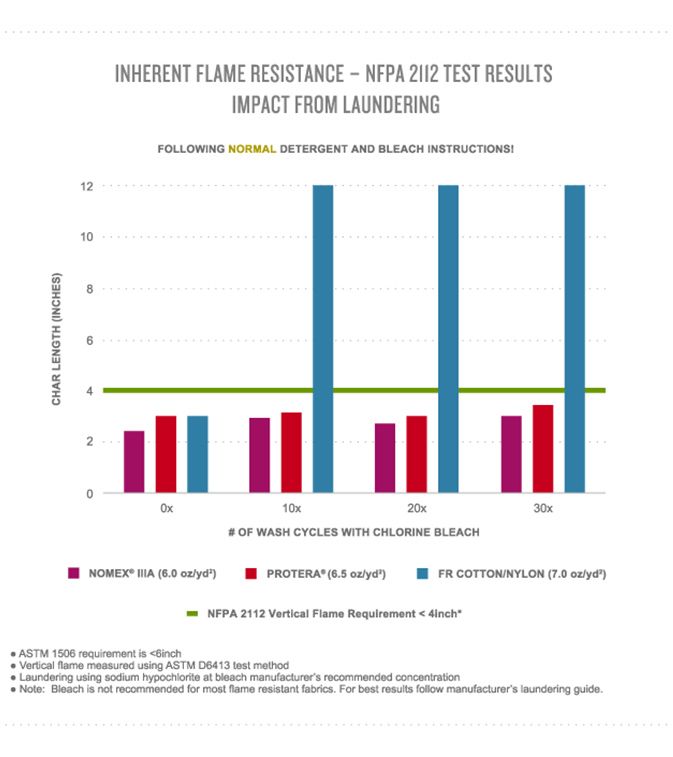Inherent versus Treated Flame Resistant Fabrics
Article | December 4, 2017
What are the differences between “inherent” and “treated” flame resistant fabrics?
Inherently flame resistant fibers are materials that have flame resistance built into their chemical structures. Aramid fibers from companies like DuPont create inherently flame resistant fibers, with brands such as DuPont™ Kevlar® and DuPont™ Nomex®. The actual structure of the fiber itself is not flammable. For inherently flame resistant fibers, the protection is built into the fiber itself and can never be worn away or washed out. In the case of Nomex®, when exposed to flame, the aramid fiber swells and becomes thicker, forming a protective barrier between the heat source and the skin. This protective barrier stays supple until it cools, giving the wearer vital extra seconds of protection to escape.
The other main category is flame-retardant treated (FRT) fabrics. These materials are made flame-resistant by the application of flame-retardant chemicals. A chemical additive in the fiber or treatment on the fabric is used to provide some level of flame retardancy. During a fire, chemically dependent fabrics rely on a chemical reaction to extinguish the flame. This reaction is triggered by the heat of the fire and the amount of time the fabric is exposed to the fire.
It is very difficult to determine whether protection has been compromised with an FRT fabric. There are ways to test it. Unfortunately, all of these test methods are destructive — there really is no way to test a garment to determine what its current level of flame resistance or arc protection value is, without destroying the garment in a flame or arc flash test.
The flame-resistant (FR) properties of inherently flame resistant fabrics, on the other hand, cannot be washed out or worn away, period. This means the flame-resistant properties of garments made of inherent fibers cannot be compromised. It is crucial for the wearer to know the flame-resistant protection is always there.
Laundering’s impact on flame resistance
An essential thing to keep in mind when assessing flame-resistant technologies is that inherent flame resistant properties cannot be washed out or damaged through exposure to chemicals in the workplace or laundering practices, whether at-home or commercial. FR-treated garments, however, may be damaged by chlorine bleach, the combination of hydrogen peroxide (“oxygen bleach”) with hard water, or exposure to oxidizing chemicals in the workplace.

What By the time you've laundered only ten times with chlorine bleach, the FR effectiveness of FR-treated cotton is, in essence, eliminated. Both fabrics made of Nomex® and Protera® maintain their flame resistance well into 30 launderings even in the presence of chlorine bleach.

Can FR properties be removed from a garment?
For FR-treated fabric, such as FR cotton/nylon blends, one way to remove its flame-resistant properties is to use regular chlorine bleach while washing the garment. While use of chlorine bleach may not be recommended per some fabric manufacturers’ laundry instructions, this can happen in the real world. It does not take many washes with chlorine bleach to damage the flame resistance of a FR cotton or cotton/nylon fabric. And unfortunately, the wearer would not be able to tell it was no longer flame-resistant simply by looking at the garment. With inherent fabrics, the flame-resistant properties cannot be removed.
Additional FR-treated garment vulnerabilities
Besides chlorine bleach, there are other chemicals that could damage the flame-resistant properties of FR treated apparel. For example, the combination of hydrogen peroxide (a type of oxygen bleach) with “hard” water during laundering could compromise the FR properties of garments made with FR-treated fabrics. And exposure to oxidizing (e.g., chlorine-containing) chemicals in the workplace may, over time, compromise the flame-resistant properties of garments made with FR-treated fabrics.
Inherent flame resistant fabrics drive overall value
Inherent flame resistant fabric-based technologies from DuPont help personnael work with constant protection. Remember, with flame-resistant fabrics made from DuPont™ Nomex® fiber and Protera®, there will be no washing out or wearing away of their inherent flame resistant properties, which helps make for a longer garment lifecycle, value and peace of mind for the wearer.